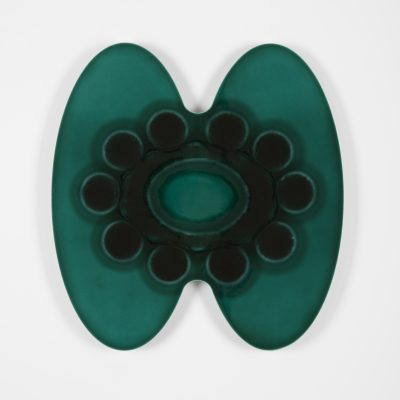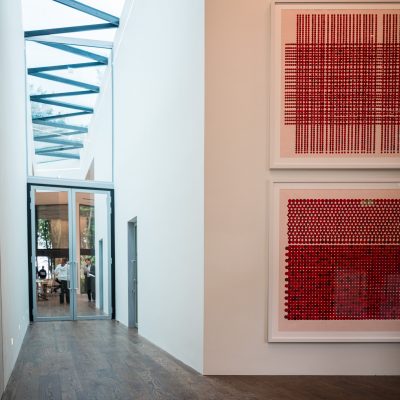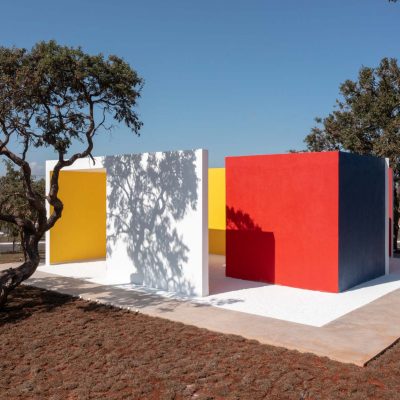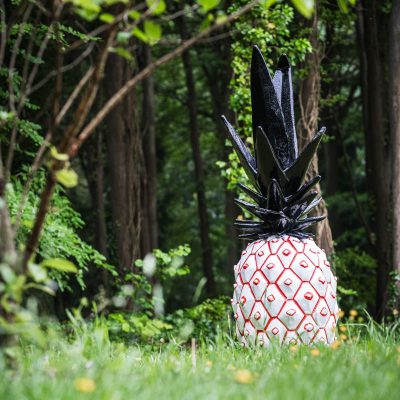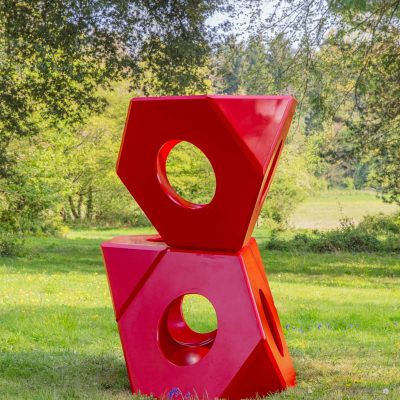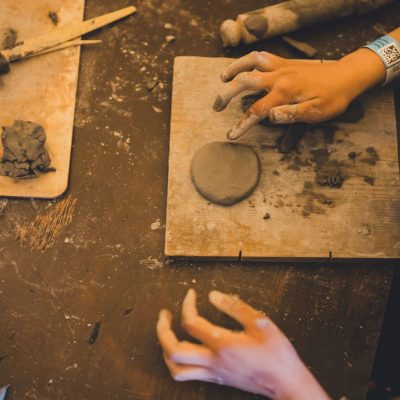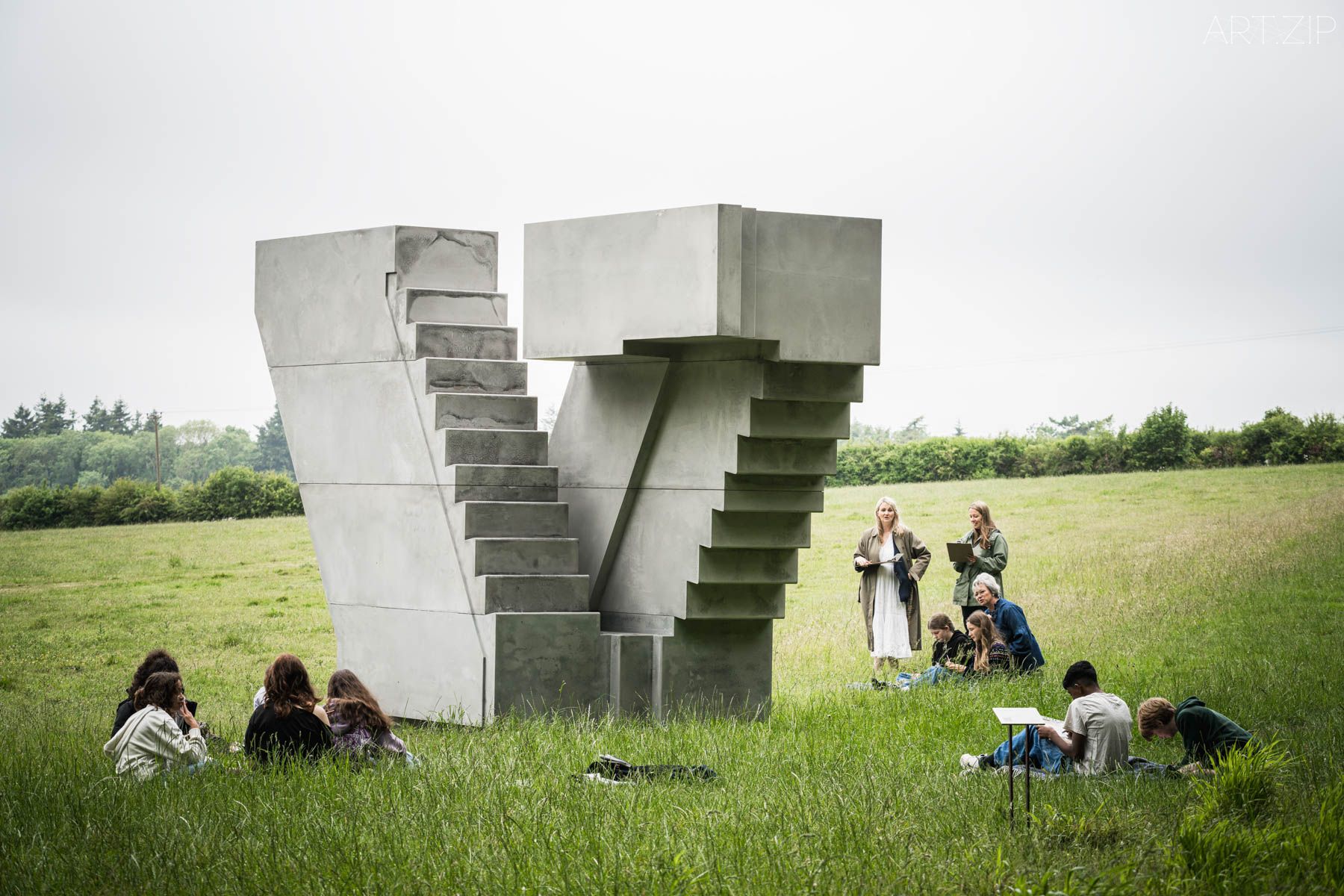
It was an honour to visit the Goodwood Art Foundation, a not-for-profit initiative launching this May and grounded in three pillars: art, environment, and education. For many, the name Goodwood first brings to mind the annual motorsport spectacles — the Festival of Speed and the Goodwood Revival. Beyond that roar, the Goodwood Art Foundation signals a different kind of momentum: world-class art in conversation with nature, with education as its core.
What role can art education play in shaping how we see, think, and live? And what particular benefits can the Goodwood Art Foundation bring to young people, families, and wider society? To explore these questions, we spoke with Sally Bacon OBE, Learning Consultant at the Goodwood Art Foundation, who shared her passion and invaluable insights. While much of today’s art world is preoccupied with the business of art — its markets, fairs, and curation, education remains its foundation, because art education cultivates aesthetic awareness, nurtures imagination, and helps us develop a deeper sense of wellbeing from childhood onwards.
Yet art education faces many challenges, from systemic gaps in access to the need for greater support from institutions, policies, and communities. As Sally Bacon highlights, building an environment where art can empower and inspire young people is essential, not only for the cultural sector but for society as a whole.
我們近日走訪了於五月啟動的 Goodwood Art Foundation,一個以「藝術、環境、教育」三大支柱為核心的非營利機構。對很多人來說,Goodwood的名字或許讓人先想到的是每年盛大的賽車活動(Goodwood Festival of Speed, Goodwood Revival); 然而在速度之外,Goodwood正以藝術基金會開啟另一條路:讓藝術與自然對話,並把「教育」放在核心使命中。
藝術教育如何影響我們的觀看方式、思考習慣與生活價值?而 Goodwood Art Foundation 又能為年輕人、家庭以及社會帶來什麼獨特的啟發?為了解開這些疑問,我們專訪了Goodwood Art Foundation 學習發展顧問 Sally Bacon OBE。她多年來投身於藝術教育領域,並分享了她的觀察與見解。她指出,當今藝術界的焦點大多放在市場、博覽會與策展,但「教育」始終是根基:藝術教育不僅能培養審美,還能啟發想像力,並從小建立起對幸福感的追求。
不過,這條路並不平坦。從教育資源的不均,到制度與政策支持的不足,藝術教育仍需社會各界更多的關注與努力。正如 Bacon 強調的:「為年輕人創造一個能讓藝術啟發和賦能的環境,是文化界和整個社會共同的責任。」
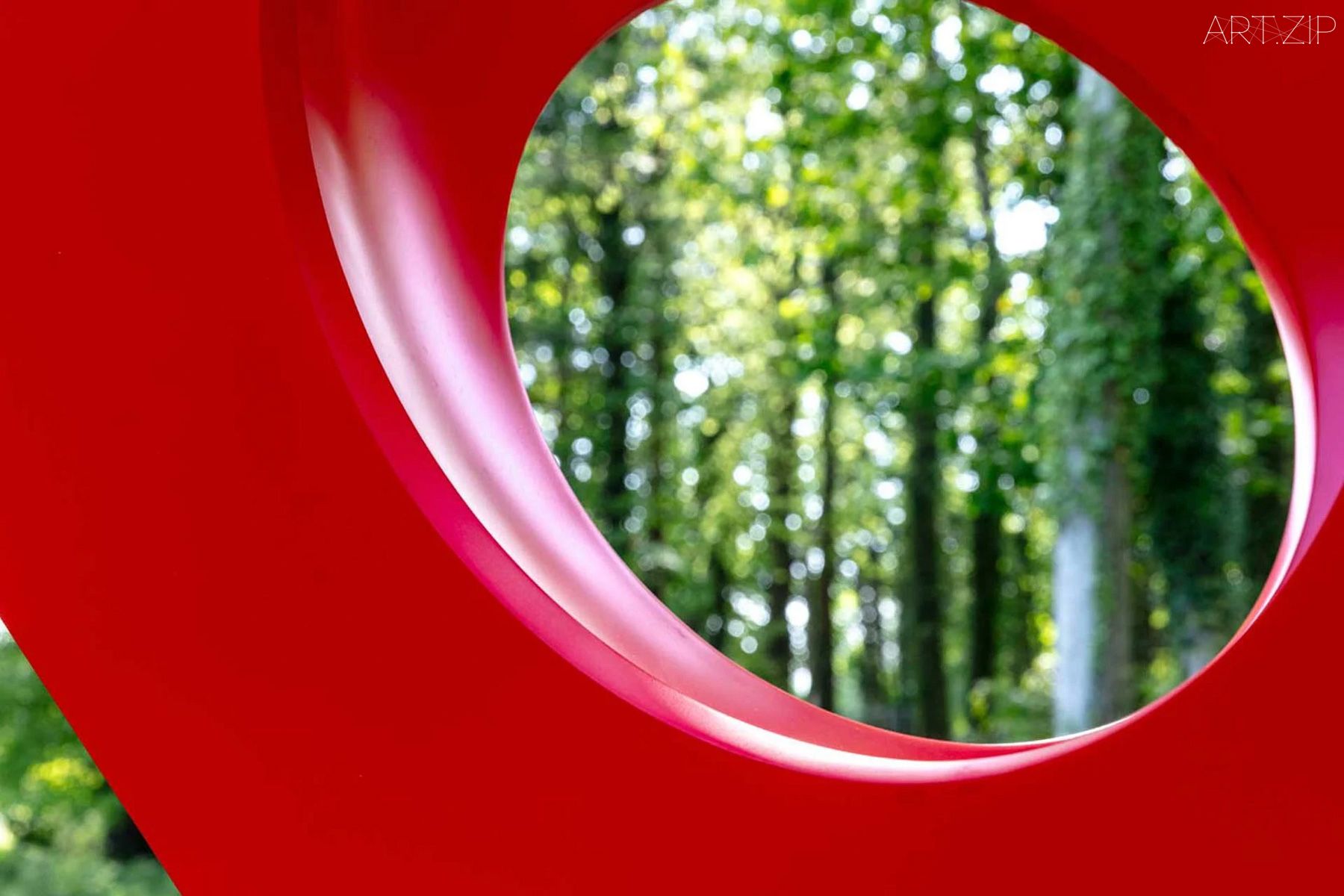
Isamu Noguchi, Octetra (three-element-stack) (1968-2021). Photo by Lucy Dawkins
AZ: You’ve spent your career bridging arts, education, and social justice. What originally motivated you to work at that intersection? How has your thinking about it changed over time?
SB: That’s a really interesting question, because we often forget where our interests begin, we get so caught up in the present that we don’t stop to think about the starting point. Looking back, my mother was a head teacher in a special needs school, so I was always connected to the world of education through her. She worked in Brixton, London, with many students who were experiencing disadvantage.
My two great loves growing up were art and literature, I adored them both equally and could never decide which to focus on. After my degree, I began a PhD exploring literature and visual arts, which I didn’t finish (as many don’t!), but it set the tone for my early career. My first job was as a learning lead in a cultural organisation in London, with a national remit. Once you’ve worn that “learning hat”, you never quite take it off, it becomes part of how you see the world.
Over the years, I’ve built a body of knowledge about the impact and importance of this work, and I’ve also seen how often it’s undervalued. People sometimes assume that galleries and cultural organisations naturally deliver strong learning programmes, but in reality, it takes deliberate effort and commitment to make them meaningful. For me, there’s a golden thread running through everything I’ve done — a blend of my passion for the arts and my mother’s dedication to education.
AZ: Could you share a moment or project that really shaped your view?
SB: One moment that really shaped my thinking happened when I was setting up the Cultural Learning Alliance, quite a while ago now. At the time, I was working at Clore Duffield Foundation , and there was a case in the news about a missing girl. I think her name was Shannon from an estate in the north of England. She had been effectively kidnapped by members of her own family for complicated and troubling reasons.
I remember speaking to the Director of Children’s Services in that area, and she told me that this child had probably never left the estate where she grew up, apart from going to school. She said, “Who would ever put a paintbrush in her hand, or a cello, or take her to a gallery, unless she experienced that through school?”
At the time, we were running a series of roundtables to explore the future of arts education. This was around 2008, and Shannon’s story was very much in the background. It stayed with me as a powerful reminder of childhood isolation and poverty, and of the reality that, for many young people, school may be the only place where they can encounter the arts.
That moment, and that period, really underscored for me why access to arts and culture should be a right for every child; a principle that became central to the work of the Cultural Learning Alliance.
AZ: 您一直在藝術、教育與社會正義之間搭橋。當初的契機是什麼?一路走來,想法有什麼變化嗎?
SB: 這是一個很有趣的問題。人往往沉浸在當下的工作裡,很少回頭想起最初的起點。我的母親是一所特殊需求學校的校長,因而我從小就與教育緊密相連。她在倫敦布里克斯頓工作,教導許多處於弱勢的學生。而我的成長歲月裡,最熱愛的兩件事便是藝術與文學,兩者對我來說同樣重要,始終無法割捨。大學畢業後,我開始攻讀博士,研究文學與視覺藝術的關係。雖然最後沒有完成(很多人都沒有!),卻為我日後的道路打下了基礎。我的第一份工作是在倫敦的一家文化機構擔任全國範圍的教育工作負責人。從那時起,教育的視角便成為我看待世界不可分割的一部分。隨著時間的推移,我更深刻地理解到這項工作的價值,但也看見它常常被低估。很多人以為美術館與文化機構自然會提供優秀的教育計畫,但事實上,這需要持續的投入與有意識的規劃。對我而言,有一條「金色主線」貫穿我所有的工作:我對藝術的熱情,還有母親對教育的堅持和奉獻。
AZ: 能不能跟我們分享一段經歷或一個項目,對你的想法產生了深遠影響?
SB: 確實有一個事件對我影響很深,那是在我創立「文化學習聯盟(Cultural Learning Alliance)」時。當時我在克洛爾·達菲爾德基金會 (Clore Duffield Foundation) 工作,新聞裡正報導一個失蹤女孩的案件。我記得她叫 Shannon,來自英格蘭北部的一個住宅區。後來發現,她其實是被自己家族裡的人綁架,背後原因既複雜又令人痛心。我還記得和當地的兒童服務主任談話時,她告訴我,這個孩子很可能從小到大除了去學校,幾乎從未離開過她居住的社區。她說:「如果不是透過學校,誰會把畫筆或大提琴交到她手上?誰會帶她去畫廊?」那段時間,我們正在舉辦一系列關於藝術教育未來的圓桌會議,大概是 2008 年左右。Shannon 的故事一直縈繞在我腦中,它讓我深刻感受到童年的孤立和貧困現實。對許多孩子來說,學校可能是他們唯一能接觸藝術的地方。那一刻,以及那段經歷,讓我更加堅信:藝術與文化的接觸必須是每個孩子的權利。這也成為「Cultural Learning Alliance」工作的重要原則。
AZ: You co-authored The Arts in Schools: Foundations for the Future in 2023. What’s the biggest takeaway from the report for people making decisions in schools right now?
SB: In the 2023 report, The Arts in Schools: Foundations for the Future, we identified three key findings, followed by ten recommendations.
The first was that arts subjects have immense value for young people’s lives. This came through so strongly in all our conversations with teachers and arts educators. The second, more sobering finding was that, despite this value, art subjects have been systematically undervalued in the state education system in England, particularly from around 2010 to 2014, and in many ways, that’s still the case now. That said, I think we’re on the cusp of change, which I can talk about.
The third finding was the need for urgent reform. This is about reforming our education systems and, crucially, what we choose to value within them. We have nothing against maths or STEM subjects, they’re vital, but education must be broad and balanced. The moment you start creating hierarchies of subjects, valuing some more than others, and holding certain subjects to intense scrutiny over exam results while ignoring results in others, you create a deeply problematic system.
In England, this imbalance has been entrenched since the introduction of the EBacc in 2010. The result is that many children are denied a well-rounded education, and when that happens over years and decades, the loss is huge. The positive side is that we know what needs to change, and in 2023 there was a growing sense that this shift is both possible and necessary.
AZ: Are there any surprises or challenges that stood out to you?
SB: Well, the current Labour government in England announced a curriculum and assessment review in September last year. These kinds of reviews don’t happen often, maybe once a decade, or even a decade and a half. It’s ongoing now and will report at the end of this year. There’s already been a call for evidence and an interim report.
At the Cultural Learning Alliance, we consulted extensively with teachers and arts educators on what the key measures should be. The Arts in Schools report actually generated a second set of recommendations for change, and we tested those in consultation.
We’re very clear: we either have to get rid of the EBacc or change it, and certainly reform our accountability measures so that art subjects are properly valued. Right now, we have a system where “strategically important” subjects exclude the arts, and that’s been the case for quite a long time.
Beyond that, we believe we need to create a national arts and education entitlement, a guaranteed minimum level of arts provision for every child. And we have to invest in the workforce, because none of this can be delivered without skilled, trained specialists.
AZ: You’ve been involved in lots of big arts education initiatives. What’s shifted most in how art is seen in schools? What do you think still needs to change urgently?
SB: We’ve definitely seen different periods. One thing we’ve realised, as with all policy areas, is that education is subject to the vagaries, policies, and whims of different governments. Ideally, education, like healthcare, wouldn’t be treated as a political football, but the reality is that it always is. There are strong ideological beliefs at play that shape thinking around education systems. In England, for the last decade and a half, we’ve been living with a “knowledge-rich*5” perspective which implies you’re filling children with facts. Of course, in the arts, we’re equally concerned with skills, opportunities, and experiences.
We’ve actually published a series of articles recently on the Cultural Learning Alliance website exploring what “knowledge-rich” means for art subjects. It’s really different from what it means in other areas of the curriculum. When we talk about the expressive arts, we’re talking about a curriculum area that offers something distinct, you can’t treat it in exactly the same way as other subjects. That’s the understanding we hope will shift.
AZ: 您在 2023 年撰寫了《The Arts in Schools: Foundations for the Future 學校裡的藝術教育:面向未來的基礎 》。對當前正在做教育決策的人而言,這份報告的最大啟示是什麼?
SB: 這份 2023 年的報告提出了三項核心發現,並延伸出十項建議。
第一,藝術科目對年輕人的生活具有巨大的價值,這在我們和教師與藝術教育工作者的交流中反覆印證。
第二個結論則相對令人沮喪:儘管藝術有這麼重要的價值,但英格蘭的公立教育體系卻長期系統性地低估藝術科目,特別是在 2010 到 2014 年之間的政策下,情況惡化,至今其負面影響仍未盡消除。不過,我認為我們正站在變革的門檻上,這很值得期待。
第三個發現是:改革的迫切性。這不僅關乎教育體制的結構,更關乎「我們到底選擇重視什麼」。我們當然不反對數學或 STEM,這些都很重要,但教育必須廣博且均衡。一旦建立科目等級,過度強調某些學科的考試成果,而忽視其他學科的價值,整個系統就會失衡。
自 2010 年引入 EBacc(英國中學教育文憑指標 )以來,這種不平衡在英格蘭被進一步固化。許多孩子無法獲得完整的教育,而當這樣的缺口累積數年、數十年,其損失是巨大的。積極的一面是:我們已經清楚需要改變什麼,而且在 2023 年,人們越來越意識到這樣的轉變不僅必要,也已具備實現的可能性。
AZ: 在這個調查過程中,有沒有讓您感到意外或特別具有挑戰性的地方?
SB: 去年九月,英國現任工黨政府宣布啟動一項課程與評估審查。這類審查其實並不常見,可能十年甚至十五年才會進行一次。目前仍在進行中,預計今年年底會有結果。到目前為止,已經完成了徵集意見和一份中期報告。
在 Cultural Learning Alliance,我們廣泛諮詢了老師和藝術教育工作者,討論未來改革的關鍵方向。《The Arts in Schools: Foundations for the Future 》這份報告在此基礎上提出了第二套改革建議,並進行了測試與驗證。我們的立場很明確:要麼廢除、要麼徹底改革 EBacc ,同時修正現有的教育問責機制,讓藝術科目獲得應有的價值定位。目前的制度將所謂「具戰略重要性」的科目排除了藝術,這種情況已經持續多年。除此之外,我們主張建立「全國藝術教育基本權益」,也就是為每個孩子保障一個最低標準的藝術教育供給(不管住哪裡、家庭背景如何,都能至少獲得某種程度的藝術課程與資源);同時,也必須投入師資與專業隊伍的培育,因為沒有受過專業訓練且具備技能的教育人員,任何改革都無法落實。
AZ: 您參與過許多大型藝術教育項目。您覺得學校裡對藝術的看法有何轉變?當下最急迫的改變是什麼?
SB: 變化確實分成不同階段。我們越來越清楚,教育和其他政策領域一樣,長期受政局更迭與意識形態左右。理想上,教育不該像醫療一樣被當成政治角力的工具,但現實往往如此。過去十五年,英格蘭主流的是「知識導向(knowledge-rich)」框架,常被理解為向孩子灌輸大量事實,強調可累積、可衡量的學科內容;然而在藝術教育裡,知識需要與創作實踐與體驗並行,才不致流於背誦。
Cultural Learning Alliance 近期在官網發表了一系列文章,探討「知識導向」對藝術科目的意涵,它與其他學科其實大不相同。談到表達性藝術(如表演與創作),我們面對的是一個提供獨特學習經驗的課程領域,不能用和其他科目完全相同的方式去處理和評量。這正是我們希望能逐步改變的既定認知。
AZ: From your national experience in arts education to your role at Goodwood, how have your previous initiatives informed the values and priorities guiding this programme?
SB: I suppose it begins with my time as Executive Director of the Clore Duffield Foundation, which I led for 23 years. Our main focus, alongside cultural leadership, was arts education. We tended to support the cultural sector, rather than schools directly, to deliver that. We funded Clore Learning Spaces — by the time I left in 2021, there were 66 of them — and while we weren’t always directly funding their programmes, I worked closely with the learning teams running them. That became my world: the language, the networks, the context in which arts education provision operates.
My work with the Cultural Learning Alliance (CLA) also instilled in me a deep commitment to social impact. When designing a programme, who most needs to benefit? Who will miss out unless we do things differently, broker relationships, sustain them, and sometimes fund them?
I’ve also been involved in many start-ups, like Turner Contemporary and Tate Modern, seeing first-hand how learning develops in a new cultural context. All of that thinking came with me into shaping Goodwood’s learning strategy.
At CLA, we work a lot with evidence, and there’s so much showing that the arts deliver wide-ranging benefits for children and young people. When we started thinking seriously about Goodwood’s learning programme more than two years ago, we were still close to the pandemic and at the beginning of the cost-of-living crisis. The social context for young people was very present in our minds.
That’s why we built the programme on three pillars: art, environment, and education. If children and young people were coming to see the art, we wanted them to experience it in a broader way: indoors and outdoors, in a beautiful landscape. That immediately led us to think more about wellbeing, immersive experiences, and the use of materials like charcoal, clay, and other natural resources that feel rooted in this setting. It became a convergence of influences that shaped a learning programme quite unlike others.
AZ: We’ve been to Goodwood, both the views and the vibe of the place are just amazing.
SB: Yes, it’s beautiful. And what’s special is that neither the landscape nor the art programme ever stands still. The grounds shift and transform with the seasons, and the exhibition changes every year, bringing in new artists, art forms, and perspectives. That constant renewal lets us explore unexpected dimensions of an artist’s work.
For example, this year we’re showing Rachel Whiteread’s photography, something many people don’t even know she creates. For young people, photography can feel especially accessible, particularly in a world where phones are such a central part of their lives. So, we think carefully about balancing art forms they can immediately connect with and those they might never have encountered before, finding ways to open doors into both. The combination of the evolving landscape and dynamic exhibitions creates so many opportunities for fresh, engaging experiences.
AZ: The Foundation focuses a lot on “art within the natural environment”. How does that shape the way you design learning experiences? How do you think being outdoors or site-specific changes the way students connect with art?
SB: I think it just brings so many different dimensions, and it will keep doing that year on year. Most young people will usually encounter art in a classroom, and if they’re lucky, in a gallery. So somehow taking those walls away feels like such a positive step. It’s helping them understand that art exists all around us, not just in a gallery space, not just on your bedroom wall or in your phone. It can exist out in the world and respond to the landscape. And that landscape, of course, changes. It grows around the work. It’s different in the morning compared to the evening, different in summer compared to autumn. That constant change makes it more immersive.
And then there’s the making, which for us has always been really fundamental. Of course there’s huge value in seeing art, exploring it, talking about it—but we want young people to make art in response too. And outdoors you’ve suddenly got this whole extra set of possibilities. It doesn’t always have to be paint or pencil—although we use those too—it might be clay, charcoal, natural materials gathered from the ground, plant-based pigments. Those things connect the making process to the place in such a rich way, and I think that’s what really deepens their engagement.
AZ: 您過往曾在全國性的藝術教育項目中工作,現在又在Goodwood藝術基金會任職。您認為過去的經驗如何影響了基金會的價值觀與教育優先順序?
SB: 這要從我在 Clore Duffield Foundation 擔任執行董事的時期談起,我在那裡工作了 23年。除了文化領導力之外,我們的主要重點就是藝術教育。我們通常支持文化機構,而不是直接資助學校來推動教育。我們資助了「克洛爾學習空間(Clore Learning Spaces)」,到我 2021 年離開時,已有 66個。雖然我們不總是直接資助他們的課程,但我與各地教育團隊緊密合作,了解他們的運作,這也成為我認識藝術教育生態的基礎。
我在 Cultural Learning Alliance 的工作也讓我對「社會影響」有深刻的承諾。在設計項目時我會問自己:誰最需要從中受益?如果我們不去改變做法、不主動牽線合作、維繫關係,甚至在需要時提供資金,誰會因此受影響、被排除在外?
我也參與過許多文化機構的新創項目,例如特納當代藝術館(Turner Contemporary)與泰特現代美術館(Tate Modern),親眼見證學習如何在新的文化場域中發展。這些經驗和思考都帶入了 Goodwood 的學習策略中。
在CLA,我們以證據為本,大量研究顯示藝術能為兒童與青少年帶來廣泛益處。兩年多前我們開始認真思考 Goodwood 的教育計畫時,仍在疫情之後,生活成本危機之初,年輕人的社會處境始終在我們腦海裡。
因此,我們以「藝術、環境、教育」三大支柱來設計項目。希望孩子們不只是欣賞藝術,而是能更廣泛地體驗藝術:室內與戶外、在美麗的自然景觀之中。這也讓我們進一步關注身心健康、沉浸式體驗,以及運用如木炭、黏土等與場域緊密連結的自然材料。這些元素的融合打造了一個與眾不同的學習計畫。
AZ: 我們到訪過Goodwood Art Foundation,無論是自然景致還是藝術氛圍,都令人印象深刻。
SB: 是的,真的非常美。而且特別之處在於,不管是風景還是藝術活動,都會不斷變化。園區隨著季節變化,展覽也會更新,引入不同的藝術家、藝術形式和觀點,讓我們得以從意想不到的角度重新探索作品。以今年為例,我們展出了 Rachel Whiteread 的攝影作品,很多人甚至不知道她也有攝影創作。對年輕人而言,攝影是一種比較親近的藝術形式,特別是在手機已成為日常核心的今天。我們會在學生熟悉的藝術形式與他們可能從未接觸過的門類之間取得平衡,幫他們打開一扇門。動態展覽加上不斷變化的景觀,可以創造許多新鮮又有趣的體驗。
AZ: 基金會特別強調「自然環境中的藝術」。這樣的理念如何影響你們的學習設計?在戶外或特定場域中學習,學生與藝術產生的聯繫與感受又有怎樣的差別?
SB: 我認為這樣能帶來許多不同層次的體驗,而且每一年都會不斷展現新的可能。大部分年輕人通常只會在教室裡接觸藝術,運氣好一點的話,也許能在美術館裡。所以,把這些「牆」拿掉本身就是一個非常積極的改變,讓他們理解藝術無所不在,不僅存在於美術館空間、房間牆上或手機螢幕裡,也能存在於外在世界,會回應環境,隨著景觀而改變。清晨和傍晚的感受不同,夏天和秋天的景象也不同。這種不斷的變化能讓體驗變得更加深刻,更具沉浸感。
此外,「創作」本身一直是非常根本的一環。當然,欣賞藝術、探索藝術、討論藝術都有其極大的價值,但我們也希望年輕人能夠透過創作來回應。尤其是在戶外,會提供一系列的可能性。創作並不一定總要用顏料或鉛筆,雖然我們也會用,還可能是黏土、木炭、就地取材的自然材料、植物染料。這些材料讓創作過程和場域緊密連結起來,而我認為正是這樣的連結深化了學生的投入。
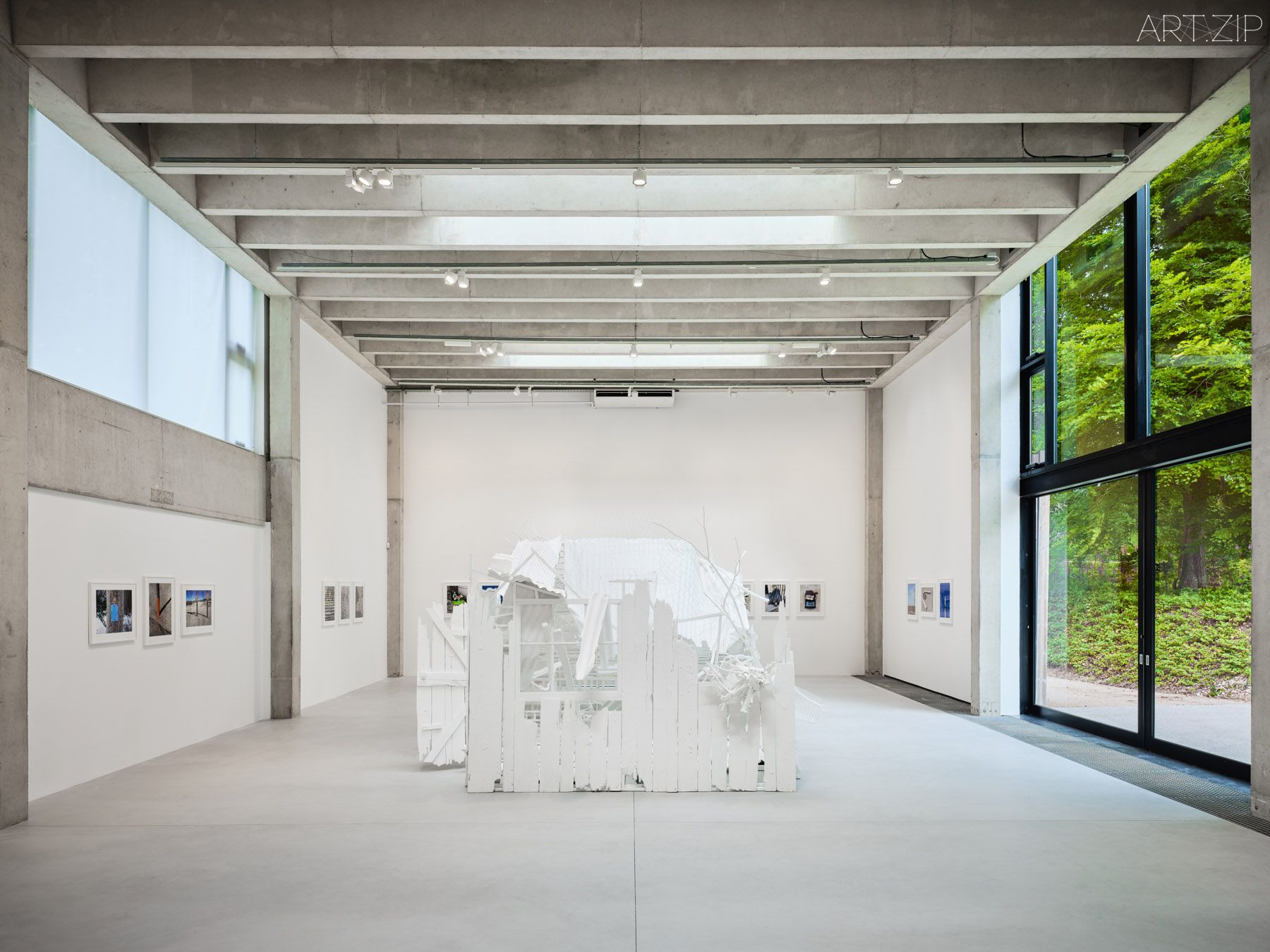
Installation view of the inaugural exhibition Rachel Whiteread at Goodwood Art Foundation. Photograph by Jonathan James Wilson, courtesy of Goodwood Art Foundation
AZ: Why did you choose Year 7 to start the “Start with Art” programme? What difference do you hope it makes early on?
SB: That’s a really good question. I think we have a problem in the education system in England, and the curriculum and assessment review that’s happening now has, I think, acknowledged it, this issue of transitions. Whatever experience a child has in primary school, to be honest, we know very little about art experiences in primary because there’s no government data. We simply don’t know how many art specialists there are, or how many hours are devoted to art.
So when young people arrive at secondary, they come with very different levels of exposure to art, entirely dependent on their primary school. Then they enter Key Stage 3 — the first three years of secondary —and over recent years we’ve seen art not always taught weekly, sometimes just on a carousel for one term. We felt it was essential that whatever their primary experience, they arrive at secondary knowing art is for them, and beginning to understand its possibilities.
That’s why we built “Start with Art” for Year 7. We wanted to say: “Welcome to secondary school. Maybe you’ve had lots of art before, maybe you haven’t, but here, come and see what art can be.” And it’s important to do that at this age, 11 or 12, because it’s a critical developmental point. Young people often have a very narrow view, often “if I’m good at drawing, I’m good at art”. But art goes much deeper than that. It’s about understanding what art is, what it can be, and what it can mean to you. This is the moment to open that door.
AZ: What role do teachers have in the Foundation’s training, CPD (Continuing Professional Development) programme? How do you think that helps spread the impact?
SB: Madeline Pike, who is now our Head of Learning at Goodwood, set up a teacher forum right from the start which was brilliant. As I’ve said before, it’s all about being responsive to what teachers actually need. With the curriculum review coming later this year, and the likelihood that the arts will be revalued in England, it’s going to be increasingly important that organisations like Goodwood Art Foundation are prepared to support teachers. We anticipate there will be growing demand for opportunities to upskill through CPD and professional learning in art and design.
That’s why consultation with teachers is at the heart of building our CPD programme. We know how limited access to CPD can be, particularly in the arts, and especially in primary schools, where there are fewer subject specialists. Often, a single teacher may be covering art, drama, and music across the board, so they don’t necessarily have the depth of training they’d like. We want to help address that gap. At the same time, we’ll be working with secondary art and design teachers, making sure that what we offer is relevant across all levels.
AZ: 為什麼選擇七年級作為「由藝術出發(Start with Art)」的起點?您希望這在學生早期能帶來哪些影響?
SB: 這個問題非常好。我認為英格蘭的教育體系確實存在一個問題,而目前正在進行的課程與評估檢討其實也已經承認了——那就是「銜接」的問題。孩子在小學階段接受的藝術教育經驗差異很大,而我們對小學藝術教育的真實狀況了解有限,政府沒有完整的相關數據,因此我們不知道小學裡究竟有多少藝術專科教師,也不知道到底投入了多少課時在藝術上。
所以當學生進入中學時,他們帶著不同的藝術基礎,這完全取決於他們的小學背景。而在 Key Stage 3(中學前三年),藝術課也並非總是每週開設,有時甚至只是以「輪替課程」的方式出現一學期。我們認為,無論孩子的小學經驗如何,進入中學後都應該清楚知道「藝術屬於他們」,並開始理解藝術的可能性。
這也是為什麼我們特別為七年級設計了「由藝術出發(Start with Art)」這個項目。我們想對新入學的孩子們說:「歡迎來到中學!或許你之前有過很多藝術經驗,也或許沒有,但這裡會帶你重新看見藝術可以是什麼。」特別是在十一、十二歲這個關鍵的發展階段,正是需要打開這扇門的時刻。因為這個年齡的孩子往往對藝術有非常狹隘的理解,比如以為「我會畫畫=我擅長藝術」。但藝術遠不止於繪畫技巧,它關乎你如何理解藝術、它可以是什麼,以及它能對你意味著什麼。
AZ: 我們留意到基金會有個CPD (Continuing Professional Development) 計畫,這是個關於教師培訓計畫,能展開介紹一下嗎?你期待它能帶來怎樣的效果?
SB: 我們學習部主管 Madeline Pike在一開始就設立了教師論壇,這是很重要的一步。正如我之前提到的,一切關鍵都在於回應教師的真實需求。隨著今年稍晚即將出爐的課綱審查,以及藝術教育在英格蘭可能重新受到重視,像Goodwood Art Foundation這樣的機構需要做好準備去支持教師。我們也預期藝術與設計領域的 CPD 和專業學習需求只會越來越大。
因此,教師諮詢是我們設計 CPD 的核心。我們非常清楚,教師在藝術相關的 CPD 機會向來有限,尤其是在小學階段,幾乎沒有專科老師。同一位老師經常要同時負責藝術、戲劇、音樂等多個領域,專業訓練自然難以深入。我們希望補上這道缺口,同時,我們也會和中學的藝術與設計教師合作,確保我們提供的資源對各個階段都具備相關性與實用性。

Rachel Whiteread, Down and Up, 2024-2025, at Goodwood Art Foundation. Photograph by Toby Adamson, courtesy of Goodwood Art Foundation
AZ: In today’s landscape of digital technology and social media, how do you think these tools are changing the ways in which the next generation views art, learns about it, and participates in arts education? What potential challenge got you concerned?
SB: I think it’s essential to recognise that young people live in a digital space. That’s their world, and we need to take that seriously. At the same time, I’ve already spoken about how important the immersive, on-site experience is nothing can quite replace that. But rather than seeing digital as in conflict with the physical, I think we should regard it as a friend, offering huge opportunities.
Artists themselves are central here, because so many already work digitally, and we’re building a team of artist educators who will help shape how this evolves. So I see the digital landscape as very rich with possibility, and as our learning programme develops, it will be exciting to explore how physical and digital experiences can sit side by side, reinforcing one another.
Talking about challenges, I suppose it comes back to the materiality I mentioned earlier, that feeling of charcoal in your hand, clay in your hand, or being out in the woods responding to sculpture or to sound installations in the landscape at Goodwood. That kind of experience is so physical, so immersive. The challenge is how you translate that into a digital space.
And I don’t think it’s only for us at Goodwood to solve. I’d like to think that artists and young people can be our guides in this. Everything we’re doing is about co-curation, about learning together. We’ll learn from our artist educators, from the cohort of artists who come into the space, from the teachers who join our forums, and from the young people themselves. That’s actually very exciting to me.
AZ: What do you think helps young people be most creative and confident today?
SB: I think the most important thing is access — that sense of universal entitlement to art education. Yes, there are groups of home-educated young people, but it’s schools where you really reach everyone. That’s where it matters most.
Coming back to the Start with Art initiative, the hope is that every child arrives at secondary school already recognising there’s this big, exciting art world out there to enjoy, experience, appreciate, and begin to understand. For that to happen, you need the right systemic support. You have to build that entitlement in the education system to give every young person the best chance of benefiting from art, of knowing what it is, what it means, what it can be for them, its potential, its variety, its challenge, even its role in activism.
So, for me, that’s really it. If government policy this autumn reaffirms that entitlement, then we’ve got everything to play for. Places like Goodwood, alongside galleries and cultural organisations everywhere, can really help to open up that world for young people.
AZ: As Learning Consultant at Goodwood Art Foundation, how does this work fit with your bigger vision for arts education? What makes this project special?
SB: When they first spoke to me about getting involved, it just felt perfect. Art is my great love, and education is my great passion, so the two things came together beautifully.
What was new for me, though, was taking it outdoors. Putting learning into a different context like that is really special. There aren’t many opportunities for young people to experience world-class sculpture outside of four walls, and Goodwood is absolutely committed to enabling them to step into its grounds and into that outdoor space. That felt like something fresh and valuable.
In many ways, it’s been a convergence of all the threads of what I do around children, young people, and access to an arts-rich education. I spend a lot of time in policy, evidence, and advocacy work, so actually being on the ground, quite literally, in the mud at the start! And watching it evolve into the beautiful foundation and galleries you see today has been a real joy.
Now we have a dedicated Learning Hub for schools, children and young people, as well as woodland space for immersive experiences. For a child from an urban context, to come into that environment is extraordinary. And we know the pressures so many young people face today — poverty, mental health challenges, difficult circumstances — so creating a space that nurtures wellbeing as well as creativity is really important.
Looking ahead, we’re also thinking about how the programme might expand beyond schools to include families, higher education students, and adults. The artist educators we work with design programmes that are very translatable into an adult context, so there’s real potential for lifelong learning here as well.
AZ: 在當下數位科技與社交媒體的環境中,您認為這些工具如何改變年輕世代觀看藝術、學習並參與藝術教育的方式?有哪些潛在挑戰值得關注?
SB: 我認為首先必須正視年輕人確實生活在數位空間裡,那就是他們的世界,我們必須認真對待。同時,我也已經提到,沉浸式的實地經驗仍無可取代。但我不認為數位和實體互相衝突;相反,它們可以成為彼此的夥伴,因為數位帶來巨大的機會。
藝術家在這裡扮演關鍵角色,因為許多人早已在數位媒介工作。我們正在建立一支由藝術家教育者組成的團隊,共同塑造這一發展方向。因此,我認為數位環境充滿可能性,而隨著學習計劃的推進,最令人興奮的是能探索如何讓實體與數位經驗並行,且互相強化。
挑戰當然還有,但「物質性」是核心,那種手裡握著木炭、觸碰黏土的感覺,或者在林間與雕塑、聲音裝置互動的體驗。在 Goodwood,這些都是具體的、沉浸的經驗。難題是:我們要如何把這樣的身體經驗轉譯到數位空間裡?我不認為這是 Goodwood 單方面能解決的問題。我希望藝術家和年輕人能成為我們的引導者。我們的方法是共創、共同策展,向藝術教育者、進駐藝術家、參與論壇的老師,以及年輕人身上學習。對我而言,這正是令人期待之處。
AZ: 您長期支持年輕人,參與過不同角色和項目,什麼最能幫助他們更有創造力和更自信?
SB: 我認為最重要的是「可及性」——一種人人都享有藝術教育的權利。當然也有一些年輕人是接受家庭教育(homeschooling),但真正能觸及所有孩子的還是學校。
回到剛才談到的項目「Start with Art」,我們希望每個孩子在進入中學時,就意識到這個龐大而迷人的藝術世界,等待著他們去欣賞、去體驗、去理解,甚至開始探索。要實現這一點就必須有系統性的支持。教育系統必須承認並建構這項權利,才能讓每個年輕人都有最佳的機會去接觸藝術,了解藝術是什麼、意味著什麼,對他們而言能成為怎樣的存在,包括它的潛能、多樣性、挑戰,甚至是它在社會行動中的角色。
對我來說,這就是核心所在。如果政府能在今年秋季的政策中重新確認這種權利,我們就有很大的施展空間。像 Goodwood ,以及各地的美術館與文化機構,都能為年輕人打開通往藝術世界的大門。
AZ: 作為 Goodwood Art Foundation 的學習發展顧問,這份工作如何連結您更宏觀的藝術教育願景?這個項目對您有何特別之處?
SB: 當我第一次受邀參與時就覺得非常契合:我熱愛藝術,也熱愛教育,而這裡正好把兩者完美結合。對我來說,全新的體驗在於將學習帶到戶外。把教育放在不同的場域,本身就很特別。讓年輕人在教室之外接觸世界級雕塑的機會並不多,而 Goodwood 堅定地致力於此,讓他們能走進莊園與自然環境中,這樣的體驗格外珍貴。
某種程度上,這像是我多年來在兒童、青年與藝術教育領域工作的總匯。我長期專注於政策、研究與倡議,而這次是真正「落地」。我記得一開始我們還在泥地裡,看著項目慢慢成形,最終發展成今天這座美麗的基金會與畫廊,整個過程讓我感到無比欣喜。
現在,我們已經有專門為學校、兒童和青少年設立的學習中心,還有林地空間可供沉浸式體驗。對城市來的孩子而言,能親身走進這樣的環境十分難得。我們也很清楚,許多年輕人正面臨貧困、心理健康和其他壓力,打造一個同時滋養創造力與幸福感的空間顯得尤為重要。
展望未來,我們也希望把計畫擴展到學校之外,涵蓋家庭、高等教育學生,甚至成人。與我們合作的藝術教育者設計的課程,其實很容易轉換到成人教育的脈絡,這也意味著這裡蘊含著真正的終身學習潛力。
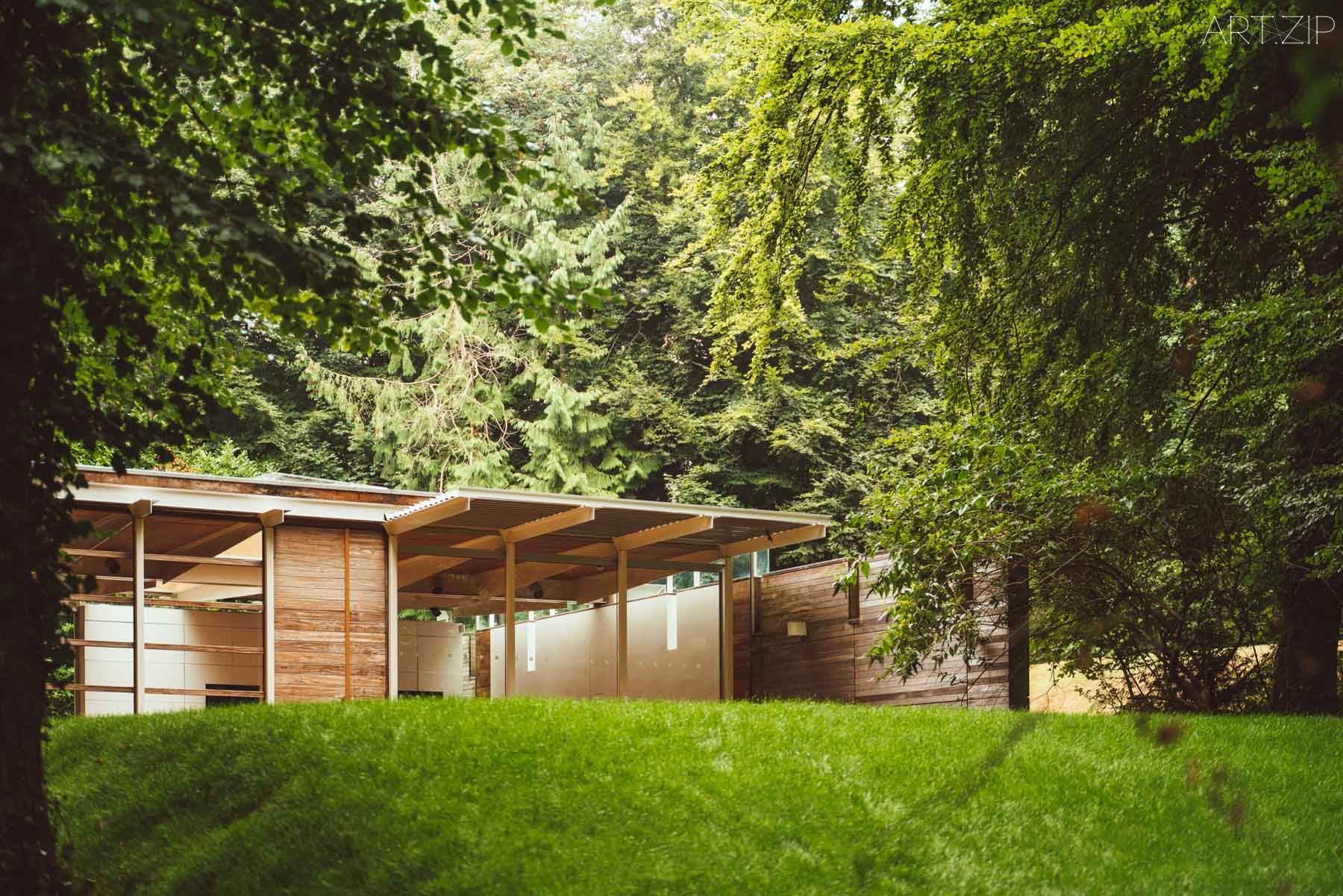
Pigott Gallery, Goodwood Art Foundation. Photo credit: Tom Baigent. Courtesy of Studio Downie Architects LLP
Interview by x 採訪 Rinka Fan
Edited by x 編輯 Michelle Yu








